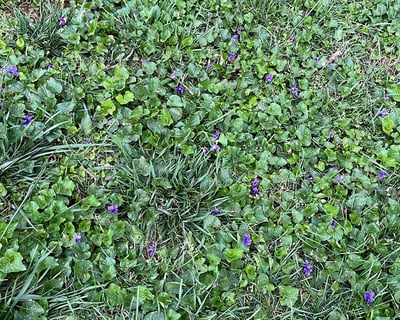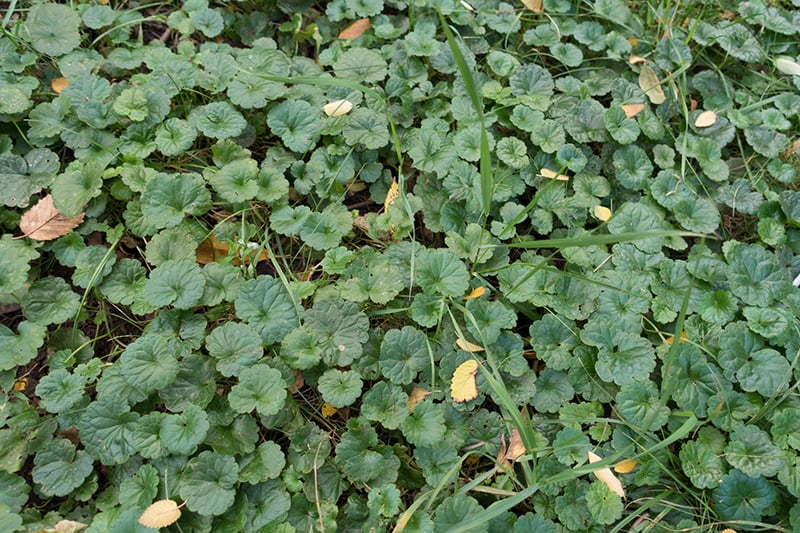

A Weed by Any Other Name: Glechoma hederacea
The original phrase comes from Romeo and Juliet, "A rose by any other name . . . "
It means all that matters is what it is, not what it is called. Glechoma hederacea has many names. It is referred to as creeping Charlie, Gill-Over-the-Ground, cat’s foot, run-away robin, field balm, and ground ivy. Don’t let those names fool you. It is an invasive weed. Once it is established, it is very difficult to control.
I recently moved from south Texas to Knoxville, TN to join the Super-Sod team. Along with the new job came a new house. There were surprises in the yard along the way. There were crocuses that sprung up by the mailbox, tulips and daffodils by the back fence, and lilies by the deck. Then there were all these beautiful blueish/purple flowers that started blooming in the yard. There are large patches everywhere and it has choked out all the grass. I have a ground ivy infestation.
I am not the only one who suffers from this. Ground ivy is a common problem in both cool and warm season lawns. It is resilient and adaptable. It usually prefers a moist and shady environment but can also be found in full sun.
Poor soil is not an issue for this weed either. It can handle soil pH levels from 5 to 7.5. Having Creeping Charlie tends to indicate that the soil is likely lacking the necessary nutrition for healthy lawns. I have not done a soil test in my yard, but I would bet my pH is acidic and the soil needs lime. It is also lacking good organic matter. I have typical East Tennessee red clay, and a top dressing of Soil³ compost will be very beneficial to my soil’s health.
General Creeping Charlie ID Features:
To control creeping Charlie, we first need to learn how to identify it.
- Family: Lamiaceae, the mint family
- Habit: Spreading, perennial groundcover. It creeps along the ground setting more roots at its nodes. This is what makes it so hard to control. Even the smallest piece left behind when pulling will result in another plant that will start creeping again.
- Leaves & Stems: Other visual identifiers of ground ivy are the four-sided stem and the ~1" wide, kidney-shaped, shiny leaves with scalloped edges. These evergreen leaves are aromatic when crushed, and arranged opposite each other on the stem.
- Roots: Fibrous
- Flowers: Lavender, violet, or purple
- Fruit/Seed: Small, brown pods containing four seeds. Creeping Charlie also spreads by these seeds.
A thick mat of creeping Charlie in full flower.
Creeping Charlie has kidney-shaped leaves with scalloped edges.
Flowers of creeping Charlie are shaped like all the flowers in the mint family.
Eat it or Treat it - How to Control Creeping Charlie
This weed is in the mint (Lamiaceae) family. When the foliage is crushed or mowed, it gives off a distinct odor. Being that it’s in the mint family, it is edible. It is native to Europe and arrived in North America in the 1800’s on early settler’s ships and it is very high in Vitamin C. This made the plant beneficial to travelers who spent months crossing the Atlantic Ocean on wooden boats. It was used in teas to help prevent scurvy. Some people still use it today in salads, soups or stews, or cook it like spinach.
As I mentioned earlier, eradicating Creeping Charlie will be very difficult.
Creeping Charlie Prevention:
- Pre-emergent herbicide: Creeping Charlie is a perennial that spreads via the roots and from seeds, so pre-emergent will only stop the spread of the plants by seeds. Keep that in mind when you spread pre-emergent and wonder why it's not working - it should work on seeds, but you will still need to address the existing population that is spreading via runners. Order pre-emergent directly from us in our herbicide store and spread it in February, April, and September.
- Mulch: Since ground ivy likes moist, shady environments, it will not be deterred by leaf mulch - I would kill it out of beds with a non-selective post-emergent herbicide, then lay landscape fabric, then spread 3-4" of triple-shredded hardwood mulch.
- Fix Bare Spots: If bald spots develop in your lawn, correct the underlying problem (such as low pH), get individual rolls of sod, and cover those bare spots before more weeds germinate or spread there.
Manual Removal of Creeping Charlie:
- Hand pull: Pulling it is not an effective method of removal. It is strenuous and time consuming with minimal results. Remember it spreads by seed, rhizome, and the stems that creep and set roots.
- Mow: Mowing helps slow it down, but this perennial species will not be eradicated by mowing.
Chemical Control of Creeping Charlie:
- Post-emergent Herbicide: Using the organic method of vinegar and citrus oil is also minimally effective. It will affect the foliage slightly and bounce back. The best way to control Creeping Charlie is to apply selective herbicide. 3-Way Max or Quincept are the products Super-Sod carries that will be effective. It will probably require a couple of applications.
Look-Alikes
Creeping Charlie can sometimes be confused with creeping Jenny (Lysimachia nummularia). The big difference is the color of the flowers. Creeping Jenny blooms yellow and creeping Charlie blooms purple.
Creeping Jenny is sometimes mistaken for creeping Charlie, but the flowers are yellow and the leaves are not scalloped.
The variegated version of creeping Charlie, called 'Variegata', is sometimes for sale in garden centers because it grows into a pretty ground cover for shady, wet conditions. However, it too is invasive.
The variegated version of creeping Charlie is also invasive.
Learn more about creeping Charlie from these websites:
All pictures for this "weed of the month" are purchased stock photos.
Questions? Leave a comment below.
Check back here for future weed profiles. Until then, happy weeding!




